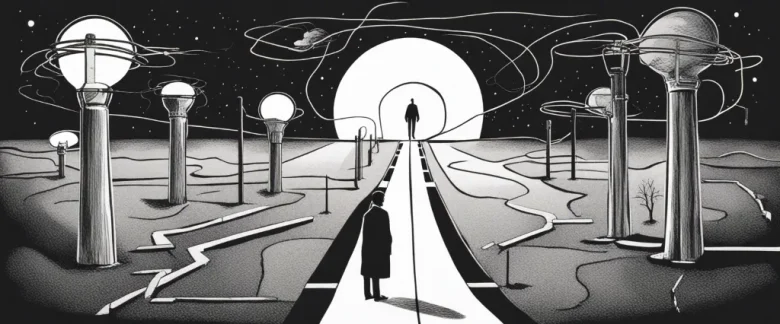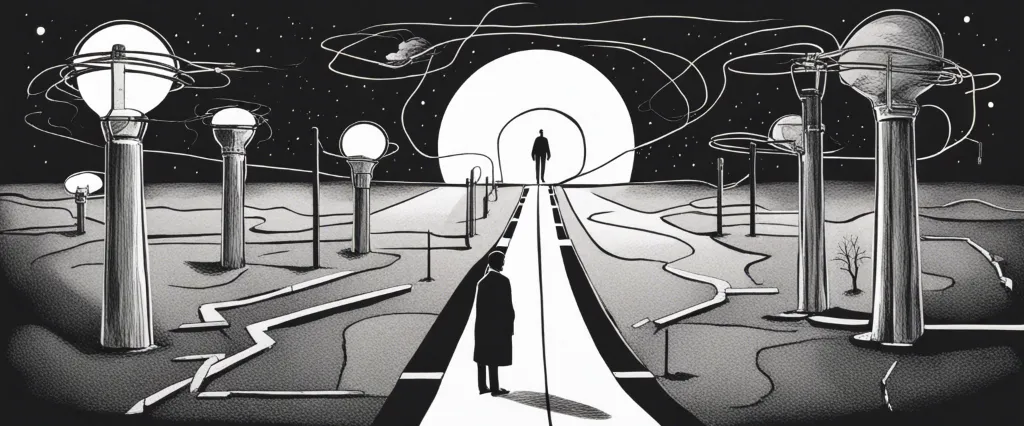In “Where Good Ideas Come From,” author Steven Johnson delves into the fascinating realm of creativity and innovation, presenting a fresh perspective on how breakthrough ideas emerge and thrive. With his extensive background in writing and researching on topics related to technology, science, and culture, Johnson is widely recognized as a leading thinker in the fields of innovation and creativity. Throughout this insightful book, he explores the patterns, environments, and conditions that foster the birth and evolution of good ideas, challenging conventional notions and providing a roadmap for cultivating innovation in our ever-evolving world.
Chapter 1: The Adjacent Possible – Exploring the Boundaries of What’s Possible
In Chapter 1 of “Where Good Ideas Come From” by Steven Johnson, titled “The Adjacent Possible – Exploring the Boundaries of What’s Possible,” the author explores the concept of the adjacent possible and its impact on the generation of innovative ideas.
Johnson introduces the concept of the adjacent possible as the space of innovation that exists next to the current state of affairs. He argues that new ideas and inventions are not sudden breakthroughs, but rather emerge from a gradual exploration of possibilities that are adjacent to the existing knowledge and technologies. This concept suggests that the likelihood of creating a successful innovation increases when more diverse and accessible adjacent possibilities are present.
To illustrate this concept, Johnson presents several historical examples. He discusses the role of coffeehouses in 17th-century Europe as a hub for creative exchange and the generation of innovative ideas due to the diverse mix of people and disciplines involved. He also explores how Charles Darwin’s theory of evolution was influenced by the diverse set of influences and discoveries available to him during his travels, which expanded his adjacent possible.
Furthermore, Johnson emphasizes the importance of networks and connections in expanding the adjacent possible. He explains that the Internet, by connecting millions of people and ideas, has exponentially increased the adjacent possible, resulting in new possibilities for innovation.
Overall, Chapter 1 of “Where Good Ideas Come From” introduces the concept of the adjacent possible as a fundamental framework for understanding how innovation occurs. It highlights the significance of diverse connections and serendipitous encounters in expanding the boundaries of what is possible, ultimately leading to the emergence of truly groundbreaking ideas.
Chapter 2: Liquid Networks – The Power of Collaboration and Connection
Chapter 2 of “Where Good Ideas Come From” by Steven Johnson is titled “Liquid Networks – The Power of Collaboration and Connection.” In this chapter, Johnson explores the concept of how innovation and creativity are fostered through collaborative networks and the exchange of ideas.
Johnson begins by discussing the significance of the coffeehouse culture in the 17th and 18th centuries, which gave rise to the Enlightenment and the Scientific Revolution. He argues that the coffeehouse acted as a hub for individuals from various professions and backgrounds to exchange information and engage in conversation, leading to the cross-pollination of ideas and accelerated intellectual progress.
Furthermore, Johnson introduces the concept of the “adjacent possible,” which refers to the space of all possible connections and ideas that can be explored at any given time. He elaborates on the importance of diverse networks in expanding the adjacent possible, promoting the intersection of different fields and increasing the chances of creating something new and remarkable.
The author then delves into the mechanism of liquid networks, which emphasize decentralized decision-making and allow for spontaneous collaboration. He provides examples of how breakthrough innovations, such as the development of GPS technology and the discovery of the cosmic microwave background radiation, were made possible through collaborations and connections across multiple disciplines.
Johnson concludes the chapter by highlighting the rise of modern networks, particularly in the digital era, which have facilitated widespread collaboration and collective intelligence on a global scale. He emphasizes the importance of fostering open platforms and environments that encourage sharing, remixing, and building upon existing ideas, as these networks have demonstrated a remarkable capacity to generate and propagate good ideas.
Chapter 3: The Slow Hunch – Nurturing Ideas over Time
Chapter 3 of “Where Good Ideas Come From” by Steven Johnson, titled “The Slow Hunch – Nurturing Ideas over Time,” explores the concept of how ideas develop and evolve over time, often through the accumulation of smaller hunches and insights.
Johnson introduces the concept of the “slow hunch” by highlighting its role in the inception of major breakthroughs and inventions throughout history. He argues that most groundbreaking ideas are not instantaneous flashes of inspiration, but rather slow-growing ideas that develop and mature over years or even decades.
The author emphasizes the importance of creating an environment that allows hunches to flourish and provides opportunities for seemingly unrelated ideas to intersect. He presents various examples, such as Darwin’s theory of evolution and the invention of the printing press, to illustrate how these breakthroughs were the result of multiple hunches coming together.
Johnson also delves into the concept of “adjacent possible,” suggesting that ideas are more likely to emerge when there is an abundance of possibilities and connections present. He notes that innovation thrives in environments with diverse and intersecting networks, as well as where there is a constant exchange of information and ideas.
Furthermore, the chapter examines the role of serendipity and the power of collaboration in nurturing ideas. Johnson explains how unexpected encounters and chance conversations can spark new connections and inspire breakthroughs.
Overall, “The Slow Hunch – Nurturing Ideas over Time” emphasizes the need to embrace the slow and gradual nature of idea development. It highlights the significance of fostering an environment that encourages the growth and evolution of hunches, allowing them to gradually transform into impactful ideas.
Chapter 4: Serendipity – Embracing Unexpected Discoveries

In Chapter 4 of “Where Good Ideas Come From” by Steven Johnson, titled “Serendipity – Embracing Unexpected Discoveries,” the author explores the role of chance and the unexpected in the process of innovation and creative problem-solving.
Johnson starts by highlighting the concept of “the adjacent possible,” which refers to the range of possibilities available at any given moment of time. He argues that innovation does not occur in a singular eureka moment but instead emerges through the combinatory nature of ideas from the adjacent possible. These ideas come together through a series of chance encounters and unexpected connections.
The author emphasizes the importance of information networks, using examples like the coffeehouses of the 17th century Enlightenment era and the modern internet. These networks allow diverse ideas to interconnect, increasing the probability of unexpected discoveries. Johnson refers to this as the “liquid network” and highlights the role of openness and collaboration in fostering innovation.
Furthermore, Johnson explores the power of error and failure in the creative process. He argues that mistakes provide an opportunity for new discoveries and advancements. He analyzes the concept of “trial and error” and presents numerous examples of how accidents, such as the discovery of penicillin by Alexander Fleming, have led to significant breakthroughs.
The chapter concludes with a discussion on how to create an environment that fosters serendipitous encounters and maximizes the potential for innovative ideas. Johnson suggests that organizations and societies should encourage diverse perspectives, provide platforms for collaboration, and embrace the unexpected in order to harness the power of serendipity.
Overall, Chapter 4 sheds light on the importance of embracing unexpected discoveries and serendipity as catalysts for innovation and problem-solving. It highlights the significance of diverse networks and the cultivation of environments that encourage chance encounters to drive creative thinking.
Chapter 5: Error – Learning from Mistakes and Failures
In Chapter 5 of “Where Good Ideas Come From” by Steven Johnson, titled “Error: Learning from Mistakes and Failures,” the author explores the role of errors and failures in the process of innovation and idea generation. Johnson argues that mistakes and failures are not merely setbacks but essential components of the creative process.
The chapter begins by highlighting the value of mistakes in scientific research. Scientists often learn the most when their experiments do not go as planned, as unexpected outcomes can lead to breakthroughs and new discoveries. Johnson emphasizes that the process of trial and error allows for incremental improvements and can ultimately lead to paradigm shifts.
Johnson also explores the concept of “adjacent possible,” which refers to the potential for new ideas to emerge within the current knowledge and technology landscape. He argues that errors and failures are crucial in expanding this adjacent possible, as they push innovators to explore uncharted territories and consider unconventional approaches.
Moreover, the author introduces the idea of “serendipity” and how it can arise from mistakes or failures. Serendipitous discoveries occur when individuals stumble upon unexpected positive outcomes while searching for something else. Johnson provides numerous examples, including the discovery of penicillin and the invention of the microwave oven, to illustrate the importance of embracing mistakes and failures to foster serendipity.
Ultimately, Johnson emphasizes the importance of creating environments and systems that encourage experimentation, collaboration, and the sharing of failures. He suggests that organizations should allow room for mistakes and not stigmatize failure, recognizing that it is often a stepping stone towards innovation and progress.
In the end, Chapter 5 highlights how embracing errors, failures, and serendipitous moments can lead to new insights, ideas, and breakthroughs. By learning from mistakes and failures, individuals and organizations can navigate the ever-expanding adjacent possible, pushing the boundaries of knowledge and fostering innovation.
Chapter 6: Exaptation – Repurposing Existing Ideas and Concepts
Chapter 6 of “Where Good Ideas Come From” by Steven Johnson is titled “Exaptation: Repurposing Existing Ideas and Concepts.” In this chapter, Johnson explores the concept of exaptation and how it contributes to the generation of innovative ideas.
Exaptation refers to the process of repurposing existing ideas, concepts, or inventions for a new and unexpected use. Johnson argues that exaptation is a crucial mechanism behind many groundbreaking inventions throughout history. He believes that looking for ways to recombine existing knowledge and materials in novel ways is a key to developing new ideas.
Johnson presents several real-life examples to illustrate the concept of exaptation. One such example is the development of the printing press, which was inspired by the mechanics of a wine press. Another example is the invention of the World Wide Web, which originated from an existing system of hypertext used for scientific research.
The author also discusses the concept of the “adjacent possible,” which refers to the range of possibilities that are available at a given moment in time. The adjacent possible is expanded through the process of exaptation, as existing innovations create new opportunities for further innovation.
Johnson emphasizes the importance of creating platforms and environments that encourage exaptation. He highlights the role of collaborative spaces, such as innovation labs, where individuals from different fields can come together and exchange ideas, as well as open access to information and technologies that allow for easy remixing and repurposing.
In summary, Chapter 6 of “Where Good Ideas Come From” explores the powerful mechanism of exaptation and how it allows for the repurposing of existing ideas and concepts to generate new and innovative solutions. Johnson encourages the creation of environments that foster exaptation and emphasizes the value of looking beyond the obvious to discover new possibilities.
Chapter 7: Platforms – Creating Environments for Innovation to Flourish
Chapter 7 of “Where Good Ideas Come From” by Steven Johnson explores the concept of platforms as environments that foster innovation. Johnson argues that platforms play a crucial role in allowing ideas to flourish by enabling the exchange and interaction among diverse individuals. He highlights several historical examples to illustrate the power of platforms in driving innovation.
Johnson starts by discussing the importance of “open platforms” that enable collaboration and information sharing. Open platforms, such as scientific journals, online communities, and marketplaces, encourage the mixing of different ideas and perspectives. The author refers to the case of the Royal Society in London, which established a platform for scientists to exchange and debate ideas. This platform led to significant advancements in various fields.
The chapter also emphasizes the significance of “adjacent possible” in platform-based innovation. The adjacent possible refers to the range of possibilities that become available in a given system based on existing elements and opportunities. Johnson explains how platforms like the World Wide Web have expanded the adjacent possible by connecting millions of people and enabling the exchange of diverse ideas and resources.
Furthermore, Johnson introduces the concept of “liquid networks” within platforms. Liquid networks refer to platforms that allow ideas to flow freely, unimpeded by hierarchies or gatekeepers. These networks foster innovation by connecting individuals and ideas that would not typically encounter each other, allowing for more diverse and innovative solutions to emerge.
Overall, Chapter 7 of “Where Good Ideas Come From” highlights the importance of platforms as catalysts for innovation. They create environments where open collaboration, diverse perspectives, and the adjacent possible can thrive, ultimately leading to the emergence of novel ideas and breakthrough innovations.

Chapter 8: The Fourth Quadrant – Combining Diverse Fields for Breakthrough Ideas
Chapter 8, titled “The Fourth Quadrant – Combining Diverse Fields for Breakthrough Ideas” from Steven Johnson’s book “Where Good Ideas Come From,” explores the concept of cross-pollination among diverse fields as a catalyst for innovative breakthroughs. Johnson introduces the idea of the “adjacent possible,” which refers to the set of potential connections and combinations that an entity can create, given its current state. He suggests that the more diverse the elements within an entity, the more extensive its adjacent possible becomes.
Johnson delves into the story of the Apollo program and how NASA faced a significant challenge in developing a pen that could write in zero gravity. Rather than relying solely on a team of pen experts, NASA opened up the problem to external perspectives, leading to the creation of the “space pen” by an inventor from Argentina. This demonstrates how combining diverse fields and enabling interdisciplinary collaboration can generate breakthrough ideas.
Moreover, Johnson examines the importance of environments that encourage cross-pollination. He highlights the role of physical spaces like coffeehouses and technology hubs as meeting grounds for people from different domains, where serendipitous encounters can spark innovation.
The author also explores the concept of exaptive innovation, where existing technologies are repurposed to solve new challenges. He cites the example of the invention of the electric guitar when musicians repurposed a telephone receiver. This exemplifies how existing solutions from one domain can be used creatively in another.
Ultimately, Johnson emphasizes that breakthrough ideas often arise from the interplay between diverse elements and disciplines. By fostering environments that facilitate cross-pollination and combining fields that appear unrelated, individuals and organizations can access a vastly expanded adjacent possible, leading to innovative breakthroughs.
After Reading
In “Where Good Ideas Come From” by Steven Johnson, the author explores the process of innovation and the environments in which innovative ideas thrive. He argues that creativity and breakthrough ideas are often the result of a slow and iterative process, rather than a sudden stroke of genius. By examining historical examples and scientific research, Johnson reveals various patterns and key factors that contribute to idea generation, such as diverse networks, the importance of collaboration, and the role of serendipity. Ultimately, the book emphasizes that innovation is not solely the product of individual brilliance, but rather a complex interplay of factors and collective efforts. By understanding these patterns and fostering conducive environments, individuals and organizations can increase their chances of generating good ideas and driving progress forward.
1. The Innovator’s Dilemma: When New Technologies Cause Great Firms to Fail” by Clayton M. Christensen – This book explores the challenges faced by established companies when disruptive technologies emerge and how to navigate through them. It delves into the concept of disruptive innovation and provides insights into how to foster creativity and sustainable growth.
2. “Creative Confidence: Unleashing the Creative Potential Within Us All” by Tom Kelley and David Kelley – Written by the founders of IDEO, one of the most renowned design and innovation firms, this book explores how to tap into your creative potential and overcome fears that hinder innovation. It offers practical exercises and real-world examples to inspire readers to embrace their creativity.
3. The Innovators: How a Group of Hackers, Geniuses, and Geeks Created the Digital Revolution” by Walter Isaacson – This book takes readers on a journey through the history of computing and highlights the stories of brilliant innovators who shaped the digital age. It provides insights into the collaborative efforts and interdisciplinary approaches that led to groundbreaking technological advancements.
4. Originals: How Non-Conformists Move the World” by Adam Grant – Focusing on the power of nonconformity, this book challenges conventional wisdom and encourages readers to embrace their unique ideas. Grant shares stories of individuals who defied the status quo and provides research-backed strategies to nurture originality and bring innovative ideas to life.
5. “The Medici Effect: Breakthrough Insights at the Intersection of Ideas, Concepts, and Cultures” by Frans Johansson – Exploring the concept of “intersecting ideas,” this book illustrates how diverse fields, disciplines, and cultures can intersect to produce groundbreaking innovation. It provides insights on fostering creativity through collaboration, diversity, and interdisciplinary thinking. The Medici Effect offers valuable lessons for generating new ideas and driving innovation.




